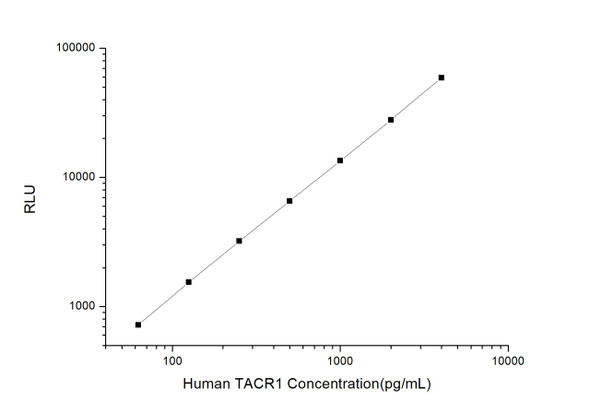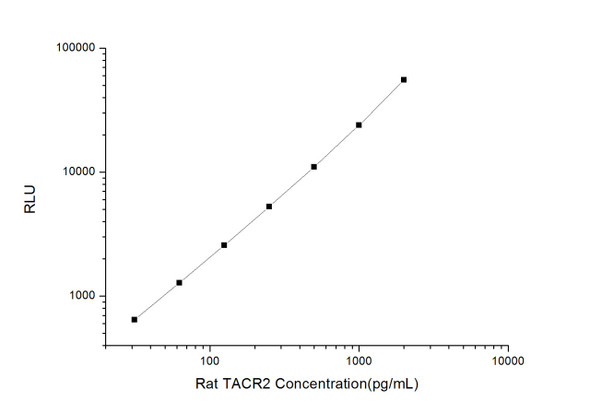Rat Signaling ELISA Kits 3
Rat TACR1 (Tachykinin Receptor 1) CLIA Kit (RTES00533)
- SKU:
- RTES00533
- Product Type:
- ELISA Kit
- ELISA Type:
- CLIA Kit
- Size:
- 96 Assays
- Sensitivity:
- 18.75pg/mL
- Range:
- 31.25-2000pg/mL
- ELISA Type:
- Sandwich
- Synonyms:
- NK1R, NKIR, SPR, TAC1R, Neurokinin 1 Receptor, Substance P Receptor
- Reactivity:
- Rat
- Sample Type:
- Serum, plasma and other biological fluids
Description
| Assay type: | Sandwich |
| Format: | 96T |
| Assay time: | 4.5h |
| Reactivity: | Rat |
| Detection method: | Chemiluminescence |
| Detection range: | 31.25-2000 pg/mL |
| Sensitivity: | 18.75 pg/mL |
| Sample volume: | 100µL |
| Sample type: | Serum, plasma and other biological fluids |
| Repeatability: | CV < 15% |
| Specificity: | This kit recognizes Rat TACR1 in samples. No significant cross-reactivity or interference between Rat TACR1 and analogues was observed. |
This kit uses Sandwich-CLIA as the method. The micro CLIA plate provided in this kit has been pre-coated with an antibody specific to Rat TACR1. Standards or samples are added to the appropriate micro CLIA plate wells and combined with the specific antibody. Then a biotinylated detection antibody specific for Rat TACR1 and Avidin-Horseradish Peroxidase (HRP) conjugate are added to each micro plate well successively and incubated. Free components are washed away. The substrate solution is added to each well. Only those wells that contain Rat TACR1, biotinylated detection antibody and Avidin-HRP conjugate will appear fluorescence. The Relative light unit (RLU) value is measured spectrophotometrically by the Chemiluminescence immunoassay analyzer. The RLU value is positively associated with the concentration of Rat TACR1. The concentration of Rat TACR1 in the samples can be calculated by comparing the RLU of the samples to the standard curve.
| UniProt Protein Function: | TACR1: This is a receptor for the tachykinin neuropeptide substance P. It is probably associated with G proteins that activate a phosphatidylinositol-calcium second messenger system. The rank order of affinity of this receptor to tachykinins is: substance P > substance K > neuromedin-K. Belongs to the G-protein coupled receptor 1 family. |
| UniProt Protein Details: | Protein type:Membrane protein, multi-pass; Receptor, GPCR; GPCR, family 1; Membrane protein, integral Cellular Component: cell surface; cytoplasm; cytosol; dendrite; integral to plasma membrane; plasma membrane Molecular Function:substance P receptor activity Biological Process: acute inflammatory response; angiotensin mediated drinking behavior; associative learning; behavioral response to pain; cell surface receptor linked signal transduction; eating behavior; elevation of cytosolic calcium ion concentration; learning and/or memory; long-term memory; neuropeptide signaling pathway; operant conditioning; positive regulation of action potential; positive regulation of blood pressure; positive regulation of epithelial cell proliferation; positive regulation of hormone secretion; positive regulation of leukocyte migration; positive regulation of lymphocyte proliferation; positive regulation of ossification; positive regulation of saliva secretion; positive regulation of stress fiber formation; positive regulation of synaptic transmission, cholinergic; positive regulation of synaptic transmission, GABAergic; positive regulation of vascular permeability; positive regulation of vasoconstriction; regulation of blood pressure; regulation of smooth muscle cell migration; regulation of smooth muscle cell proliferation; response to electrical stimulus; response to estradiol stimulus; response to ethanol; response to heat; response to hormone stimulus; response to morphine; response to nicotine; response to organic cyclic substance; response to ozone; response to pain; response to progesterone stimulus; sensory perception of pain; smooth muscle contraction involved in micturition; sperm ejaculation; tachykinin signaling pathway |
| NCBI Summary: | mediates neuropeptide signaling; may play a role in pain sensitivity; may mediate baroreflex transmission for blood pressure regulation [RGD, Feb 2006] |
| UniProt Code: | P14600 |
| NCBI GenInfo Identifier: | 128360 |
| NCBI Gene ID: | 24807 |
| NCBI Accession: | P14600. 1 |
| UniProt Related Accession: | P14600 |
| Molecular Weight: | 46,366 Da |
| NCBI Full Name: | Substance-P receptor |
| NCBI Synonym Full Names: | tachykinin receptor 1 |
| NCBI Official Symbol: | Tacr1 |
| NCBI Official Synonym Symbols: | Tac1r |
| NCBI Protein Information: | substance-P receptor |
| UniProt Protein Name: | Substance-P receptor |
| UniProt Synonym Protein Names: | NK-1 receptor; NK-1R; Tachykinin receptor 1 |
| UniProt Gene Name: | Tacr1 |
| UniProt Entry Name: | NK1R_RAT |
As the RLU values of the standard curve may vary according to the conditions of the actual assay performance (e. g. operator, pipetting technique, washing technique or temperature effects), the operator should establish a standard curve for each test. Typical standard curve and data is provided below for reference only.
| Concentration (pg/mL) | RLU | Average | Corrected |
| 2000 | 53678 57764 | 55721 | 55693 |
| 1000 | 22915 25033 | 23974 | 23946 |
| 500 | 11107 10957 | 11032 | 11004 |
| 250 | 5131 5457 | 5294 | 5266 |
| 125 | 2619 2597 | 2608 | 2580 |
| 62.5 | 1337 1285 | 1311 | 1283 |
| 31.25 | 661 687 | 674 | 646 |
| 0 | 28 28 | 28 | -- |
Precision
Intra-assay Precision (Precision within an assay): 3 samples with low, mid range and high level Rat TACR1 were tested 20 times on one plate, respectively.
Inter-assay Precision (Precision between assays): 3 samples with low, mid range and high level Rat TACR1 were tested on 3 different plates, 20 replicates in each plate.
| Intra-assay Precision | Inter-assay Precision | |||||
| Sample | 1 | 2 | 3 | 1 | 2 | 3 |
| n | 20 | 20 | 20 | 20 | 20 | 20 |
| Mean (pg/mL) | 108.21 | 295.83 | 708.96 | 117.30 | 278.85 | 662.17 |
| Standard deviation | 12.83 | 26.15 | 73.38 | 14.39 | 19.58 | 59.53 |
| C V (%) | 11.86 | 8.84 | 10.35 | 12.27 | 7.02 | 8.99 |
Recovery
The recovery of Rat TACR1 spiked at three different levels in samples throughout the range of the assay was evaluated in various matrices.
| Sample Type | Range (%) | Average Recovery (%) |
| Serum (n=5) | 100-113 | 106 |
| EDTA plasma (n=5) | 83-95 | 90 |
| Cell culture media (n=5) | 94-110 | 101 |
Linearity
Samples were spiked with high concentrations of Rat TACR1 and diluted with Reference Standard & Sample Diluent to produce samples with values within the range of the assay.
| Serum (n=5) | EDTA plasma (n=5) | Cell culture media (n=5) | ||
| 1:2 | Range (%) | 89-100 | 100-116 | 98-113 |
| Average (%) | 95 | 107 | 106 | |
| 1:4 | Range (%) | 98-112 | 89-103 | 99-116 |
| Average (%) | 104 | 97 | 108 | |
| 1:8 | Range (%) | 94-109 | 91-106 | 102-116 |
| Average (%) | 100 | 97 | 109 | |
| 1:16 | Range (%) | 91-106 | 91-101 | 92-108 |
| Average (%) | 98 | 96 | 100 |
An unopened kit can be stored at 4°C for 1 month. If the kit is not used within 1 month, store the items separately according to the following conditions once the kit is received.
| Item | Specifications | Storage |
| Micro CLIA Plate(Dismountable) | 8 wells ×12 strips | -20°C, 6 months |
| Reference Standard | 2 vials | |
| Concentrated Biotinylated Detection Ab (100×) | 1 vial, 120 µL | |
| Concentrated HRP Conjugate (100×) | 1 vial, 120 µL | -20°C(shading light), 6 months |
| Reference Standard & Sample Diluent | 1 vial, 20 mL | 4°C, 6 months |
| Biotinylated Detection Ab Diluent | 1 vial, 14 mL | |
| HRP Conjugate Diluent | 1 vial, 14 mL | |
| Concentrated Wash Buffer (25×) | 1 vial, 30 mL | |
| Substrate Reagent A | 1 vial, 5 mL | 4°C (shading light) |
| Substrate Reagent B | 1 vial, 5 mL | 4°C (shading light) |
| Plate Sealer | 5 pieces | |
| Product Description | 1 copy | |
| Certificate of Analysis | 1 copy |
- Set standard, test sample and control (zero) wells on the pre-coated plate and record theirpositions. It is recommended to measure each standard and sample in duplicate. Note: addall solutions to the bottom of the plate wells while avoiding contact with the well walls. Ensuresolutions do not foam when adding to the wells.
- Aliquot 100µl of standard solutions into the standard wells.
- Add 100µl of Sample / Standard dilution buffer into the control (zero) well.
- Add 100µl of properly diluted sample (serum, plasma, tissue homogenates and otherbiological fluids. ) into test sample wells.
- Cover the plate with the sealer provided in the kit and incubate for 90 min at 37°C.
- Aspirate the liquid from each well, do not wash. Immediately add 100µL of BiotinylatedDetection Ab working solution to each well. Cover the plate with a plate seal and gently mix. Incubate for 1 hour at 37°C.
- Aspirate or decant the solution from the plate and add 350µL of wash buffer to each welland incubate for 1-2 minutes at room temperature. Aspirate the solution from each well andclap the plate on absorbent filter paper to dry. Repeat this process 3 times. Note: a microplatewasher can be used in this step and other wash steps.
- Add 100µL of HRP Conjugate working solution to each well. Cover with a plate seal andincubate for 30 min at 37°C.
- Aspirate or decant the solution from each well. Repeat the wash process for five times asconducted in step 7.
- Add 100µL of Substrate mixture solution to each well. Cover with a new plate seal andincubate for no more than 5 min at 37°C. Protect the plate from light.
- Determine the RLU value of each well immediately.






